How Crocodilians, [Alligators, Dinosaurs] Are Similar Explained by Classification
Are Alligators Related To Dinosaurs is a question that can really spark the imagination. When we look at modern-day animals, especially fast and aggressive reptiles, it is easly to imagine the similarity to dinosaurs from the skin and teeth. However, the answer is not so straightforward as there are no living dinosaurs and only a few skeletons with skin depicting the real dinosaur. Luckily, we have tools and scientists to help us understand the relationships, like classification, dinosaur fossils, and of course, the living alligators themselves.
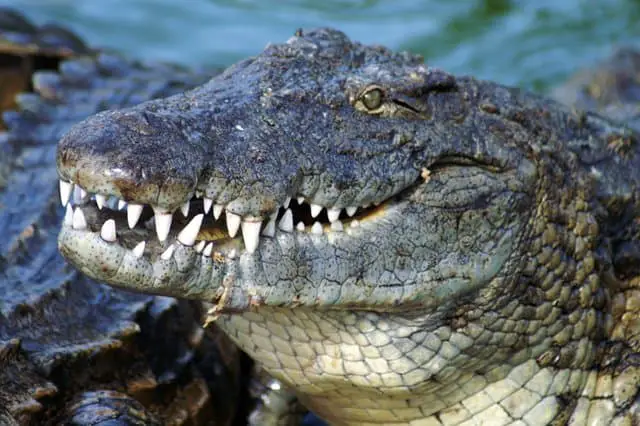
Are Alligators Related To Dinosaurs?
Yes, both alligators and dinosaurs are archosaurs that have common ancestors from the mid-Triassic period, roughly 230 million years ago. They share common characteristics such as laying eggs, long hind legs, and short forelimbs and teeth that are set in sockets.
Key Takeaways
- Alligators and dinosaurs are classified as archosaurs under both Linnaean and Phylogenetic systems.
- Alligators, evolving from dinosaur ancestors, share a common ancestry with crocodiles in the archosaur division.
- Pseudosuchia, a classification of reptiles, showcases common features between alligators and dinosaurs.
- Alligators and dinosaurs coexisted, with ancient species of alligators living alongside dinosaurs in certain time periods.
- Anatomical similarities between alligators and the Spinosaurus dinosaur demonstrate the evolutionary connection between these species.
- Alligators are regarded as living links to prehistoric times, evoking fascination and highlighting their importance in prehistory.
It’s also important to point out some of the details of modern classification that will enable you to see the bigger picture and then also to cover some of the differences as well as the similarities that dinosaurs and alligators had in common.
Alligators and Dinosaurs, both constituents of the archosaur group, possess an intertwined evolutionary narrative deeply rooted in Earth’s prehistoric times. Today’s representative Alligator species, the American Alligators, owe their existence to their prehistoric ancestors who shared a world with the dinosaurs.
Table of Contents
The keys to this fascinating relationship lie buried in the preserved remnants of the past – fossils. As silent testaments to lives lived eons ago, these fossils allow the field of paleontology to unfold the mysterious chapters of extinctions and evolutions.
Biology, more specifically genetics, steps in to weave together these fragmented tales of the past into a coherent narrative. Through genetics, the threads of biodiversity unfurl to reveal a rich tapestry, resplendent with a multitude of species, from the mighty dinosaurs to the resilient reptiles. As each species evolves, it adds its own unique hue to this tapestry.
Understanding the past doesn’t just enrich our knowledge of biodiversity; it also prepares us for the future. The extinctions of the past hold lessons for the future.
By learning more about how and why the dinosaurs, and other species, disappeared, we could potentially avert similar crises in the future. Thus, the relationship between alligators and dinosaurs isn’t just a study of the past; it’s also a stepping stone towards understanding and preserving our future.
Because both came from a common ancestor, we’ll take a look at the groups of those common ancestors and try to match it to a rough timeline. Let’s jump in.
Is an Alligator a Dinosaur? Scientific Classification Can Help Clarify – Crocodilians: The Crocodile Family
To answer what dinosaurs did alligators evolve from – or more specifically – are alligators dinosaurs, we need to understand a bit of scientific classification to illustrate scientists’ thinking.
The Two Basic Classification Systems
Taxonomy and classification is something that continues to change and evolve as more extinct species are found and also because our knowledge of living species is growing. There are two common classification methods.
● The Linnaean- In this system, which was created and developed by Carolus Linnaeus during the 1730s, it groups organisms by physical characteristics and doesn’t always consider or factor in what ancestors they came from. The classification that is often taught in schools uses this system.
● The Phylogenetic – Developed in the early 20th century, in this system, the ancestors are given priority and grouped by ancestry, using characteristics to help discover who the ancestors are. It uses clades, which was coined by Lucien Cuénot in 1940.
Many paleontologists like using this system to classify dinosaurs. Some paleontologists or paleobiologists have further evolved the thinking of the Phylogenetic classification to include new fossil discoveries. I find it useful because they use clades or groups.
The cool thing about using these two classification systems is what it gives you when using both of them together. It helps to give a broader view of both dinosaurs and modern-day reptiles, using their strengths of each system as needed to make things more understandable, and in a visual way.
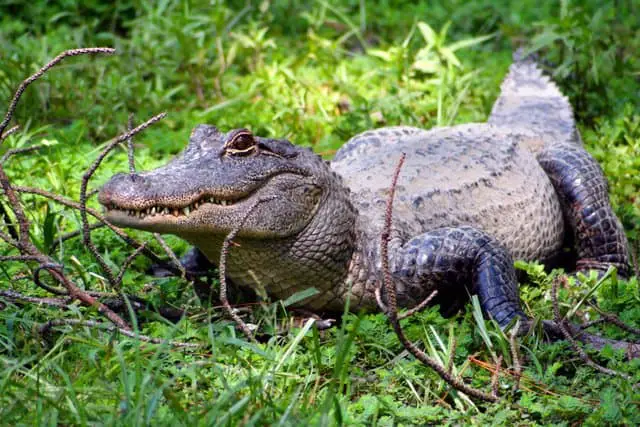
Modern classification uses a mix of Linnaean Classification and the Phylogenetic System. Although there are many additions and adjustments as biologists work with the system and publish new versions, one of the most easily visible is the inclusion of clades in the listing of taxonomy.
I think it is not only interesting but useful as well, to cover each system separately so that we get a deeper understanding.
Classifications of Ancestral Alligators Related to Dinosaurs
When taking a look at what dinosaur did alligators evolve from, it is probably more accurate to ask what group of dinosaur ancestors did alligators evolve from. In this way, we can take a look at classifications of extinct dinosaurs and find the closest group.
All reptiles had common ancestors based on the characteristics of the Archosaurs. Using the Linnaean classification system, here is a simplified breakdown of Archosaurs, which highlights dinosaurs and reptiles.

The Linnaean classification system tells us that, in general, all Archosaurs were Amniotes. They laid eggs that didn’t need water to survive, the eggs had a substantial amount of yolk and had a harder shell so it could endure on land.
I’ll detail the common features for dinosaurs and alligators later in the article.
Here is a shortlist of the physical features of Archosaurs that evolved and that are present in ancestors of dinosaurs and alligators (Source):
● A lightened skull which enable more organ tissue developments
● The presence of serrated teeth set in sockets on the top and bottom of the jaw
● The fifth toe on the claw reduced in size
● Double row of bony plates which ran along the backbone to its tail
Now let’s take a look at the Phylogenetic classification.
As mentioned, sorts animals by ancestry and gets help from the animal’s characteristics to better determine its ancestors as well as using clades (or groupings) to visualize the classification better. In structure, it uses Linnaean classification as a base.
I’ll simplify the structure to stay focused on showing how alligators are related to dinosaurs, but keep in mind that there are volumes of research on each classification topic, and this is just a snapshot.
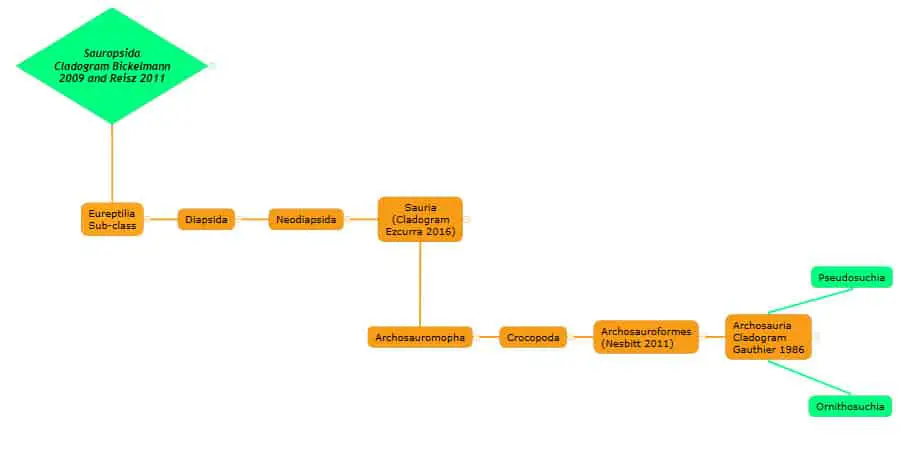
The ancestral amniotes were divided into two main categories, Reptiles, and Synapsids.
Reptiles were divided into three categories, which led two of them to modern reptiles. The third category was Diapsids. Diapsids were evolving between 250 to 201 million years ago at the end of the Triassic period.
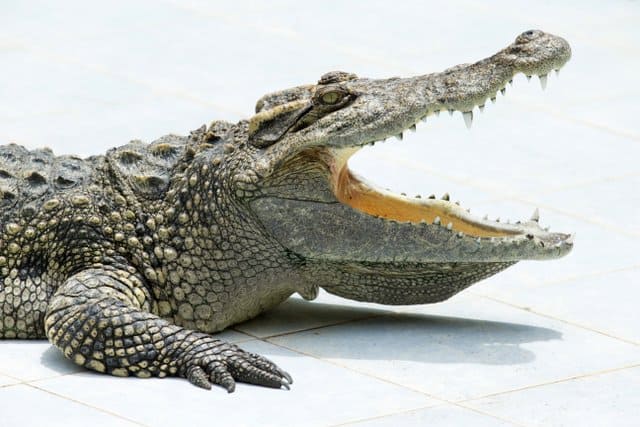
Starting in the Jurassic period, some animals started to evolve with new characteristics. From this point, there is a stronger relationship of alligators to dinosaurs with a common group of ancestors.
The category of Diapsids had four sub-categories. The Archosaurs were the ancestors of both dinosaurs and alligators.
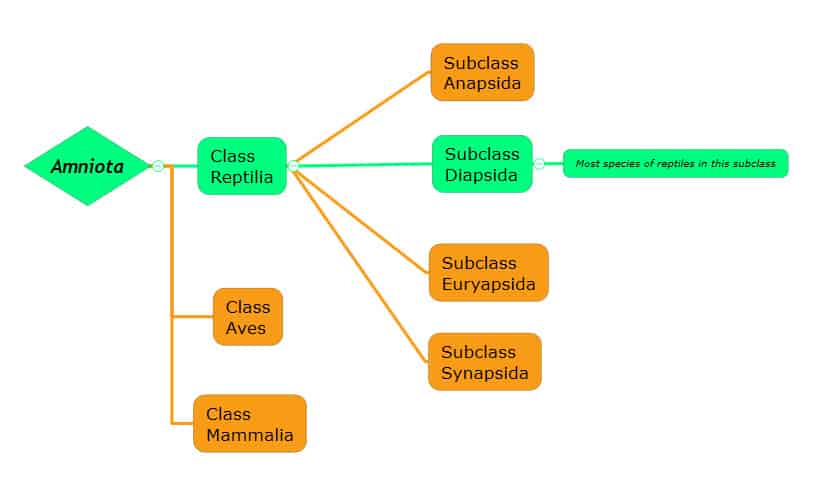
One way to answer the question about what dinosaur group did alligators evolve from simply is, based on what we have covered, to say that:
Alligators are Archosaurs that evolved from dinosaur ancestors that were Amniotes (egg-laying) and Diapsids (having two arches on the skull).
Moving further on to the sub-groups of Archosaurs, about 141 million years ago during the Jurassic period, the branch of Archosaurs divided into three main groups.
- The first sub-category was Pterosaurs. These were the reptiles that could fly.
- The second was Dinosaurs. From this point forward, the era of dinosaurs had begun, and they ruled the world for millions of years until the C-T Extinction. This grouping of dinosaurs evolved, resulting in hundreds of new species, including carnivores like T-Rex and the plant-eating, long-necked Sauropods.
- The third and last group was Crocodilians from which modern-day alligators and crocodiles evolved from.
Let’s look at the classification of crocodiles and alligators for further clarity on how alligators are related to dinosaurs.
————————————————————————————————
Related Dinosaur Articles You Might Also Be Interested In:
Herbivore Dinosaurs – What’s So Cool About Them? (Types, Sizes, Facts)
The 13 Best-Known, Most-Loved Dinosaurs and Why
What Are Long Neck Dinosaurs (Types, Size, List)?
————————————————————————————————
Classification of Reptiles – Pseudosuchia
Let’s take a look at the Phylogenetic system’s classification of Reptiles, which are Pseudosuchia. In the Phylogenetic system, it can be more detailed with multiple branches (or Clades) as it links extinct animals as well as current living animals.
Here are the simplified versions of Phylogenetic clades for Vertebrata, which lead to dinosaurs and reptiles.
Finally, here is the combined modern version from 2011. I use this one because it details the clades specifically to Crocodilia and Dinosaurs, which is the focus of the article. See Figure 4 below. It will help with the discussion.
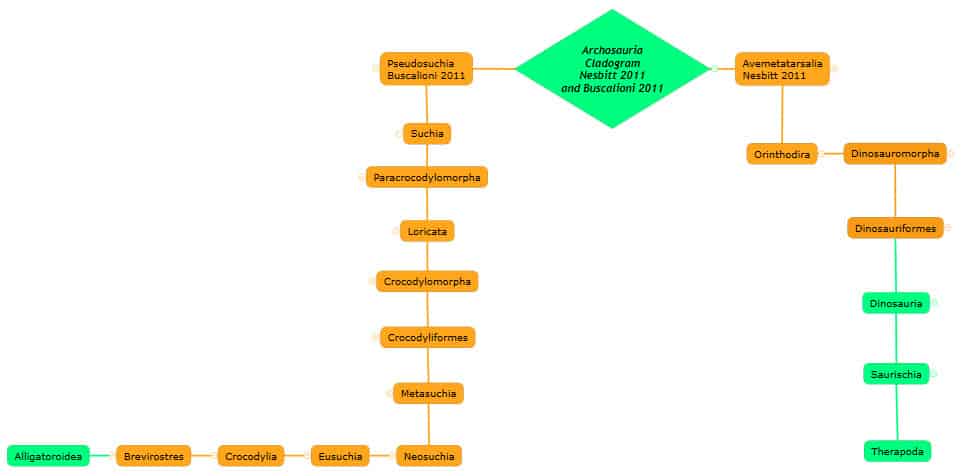
Modern classification for Archeosaurs definition is structured as:
● Kingdom -Animalia
● Phylum -Chordata
● Class -Reptilia
● Clade -Archosauria
Classification of Dinosaurs – Avemetatarsalia- (From Crown Group Archosauria)
The Phylogenic cladogram of Avemetatarsalia (Source) has branches grouped, starting with Avemetatarsalia. It has two branches, Orinthodira and Dinosauromorphia. See Figure 4 above.
It is here where you can see the connection between birds and dinosaurs. Up until here, dinosaurs and birds have common features. After this, these two branches then develop separately.
From Dinosauromorphia, it further groups into Dinosauroformes and then Dinosauria, where the clades include the species of dinosaurs. It breaks down further into Saurischia and Theropoda.
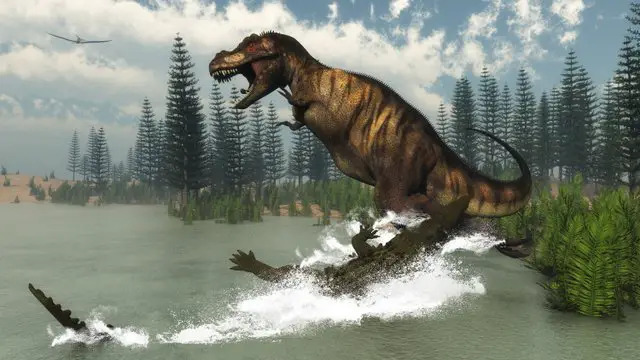
Did Alligators Live with Dinosaurs? What Alligators, Dinosaurs Had In Common
Dinosaurs lived throughout the Mesozoic era, the earliest estimated to have appeared during the Triassic period. They evolved from reptiles, and the distinguishing characteristics as per modern classification is that they were Amniotes, had Diapsid skull and the Orinthian hip.
It’s exciting to realize the fact that during the Mesozoic era, other important species were living alongside the dinosaurs that were evolving and also had an impact on the prehistoric eras. It’s often overlooked since dinosaurs were so predominant.
One of these groups was the Crocodilia, from which alligators came from.
The geological eras in which the dinosaurs lived was the Mesozoic, ending in the C-T Extinction that happened in the Cretaceous period at the end of the Mesozoic. The ancestors of alligators survived the C-T Extinction and survived in the modern-day Cenozoic geological era.
Did Alligators Exist with Dinosaurs? Ancient Species of Alligator
Yes, ancient species of alligators (and multiple species of crocodiles) lived at the same time as dinosaurs.
Several species of the order Crocodilia that include Crocodiles and Alligators of the modern-day evolved during the Mesozoic era. In terms of looks, the amazing thing is that modern-day alligators and crocodiles didn’t look too different from those of today.
The earliest alligator ancestors evolved during the Triassic, then in the late Cretaceous, one fossil that was found to be an Alligatoroid was Brachychampsa.
Brachychamsa evolved during the late-Cretaceous, and fossil remains have been found in Montana, USA, and Kazakhstan. As mentioned above, it looked similar to modern-day alligators. One biological difference was an enlarged tooth in the upper jaw of the Brachychamsa (Source Wikipedia)
Deinosuchus was also a closely related ancestor to alligators, classified as a match to modern-day crocodiles. Like Brachychamsa, it lived during the late-Cretaceous. Its fossils have been found in North America and Mexico. It was considerably larger than modern-day alligators at 12m (39 ft), and scientists believe it preyed on plant-eating dinosaurs. (Source)
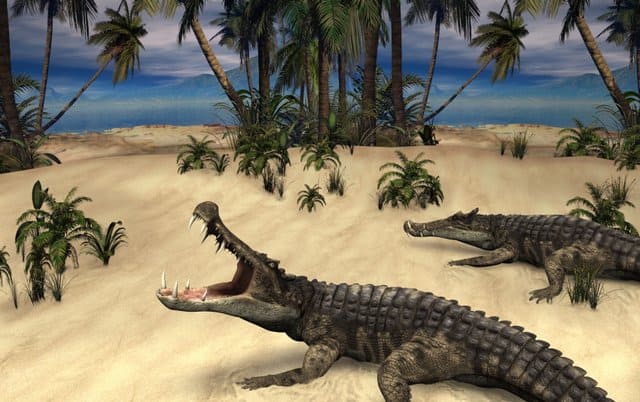
What Time Period Did Alligators and Dinosaurs Live Together
If we talk about the time period at which dinosaurs and alligators were sharing the world, we have to go back a long time. As we know, the first dinosaurs appeared approximately 230 million years ago.
Some of the first dinosaurs, such as the Plateosaurus was one of the first dinosaurs that appeared, and they lived until the Cretaceous-Tertiary mass extinction (C-T Extinction). Some species were thought to be the survivors of C-T Extinction.
The first of the ancestors of alligators emerged from Diapsids about 245 million years ago. These were the Archosaurs, and they were the common ancestor of alligators and dinosaurs. The first crocodilians approach about 90 million years ago during the Cretaceous period.
The first alligator species, now extinct, was Brachychampsa. They lived about 93.5 million years ago and went extinct 63 million years ago.
So, we can estimate that during the time of dinosaurs, there were an ancient species of alligators that existed, and they shared the earth about 30 million years, which is quite a long time frame.
The Mesozoic Era: Age of Reptiles
Step back in time to the Mesozoic Era, the age of reptiles, and witness the dominance of alligators and dinosaurs. The Mesozoic Era, which is divided into three periods – Triassic, Jurassic, and Cretaceous – was a time of incredible reptilian diversity. Beyond dinosaurs, a wide range of reptiles thrived during this era. Environmental factors played a significant role in shaping the evolution of reptiles in the Mesozoic Era. The table below provides a glimpse into the diverse reptilian groups that existed during this time and the environmental factors that influenced their evolution.
| Reptilian Group | Characteristics | Environmental Factors |
|---|---|---|
| Dinosaurs | Terrestrial | Changes in climate |
| Plesiosaurs | Aquatic | Oceanic conditions |
| Pterosaurs | Flying | Atmospheric changes |
| Ichthyosaurs | Marine | Adaptation to water |
The Mesozoic Era was a time of remarkable reptilian diversity, with various groups adapting to different environments. The changes in climate, oceanic conditions, atmospheric composition, and the availability of water played crucial roles in shaping the evolution of reptiles during this era. Beyond the well-known dinosaurs, reptiles such as plesiosaurs, pterosaurs, and ichthyosaurs also flourished in their respective habitats. By understanding the reptilian diversity in the Mesozoic Era, we gain insights into the complex interplay between organisms and their environment during this transformative period in Earth’s history.
The Cretaceous-Paleogene Extinction Event
Witness the catastrophic event that wiped out up to 75% of all species on Earth, including dinosaurs, in the Cretaceous-Paleogene extinction event.
This mass extinction event occurred at the end of the Cretaceous Period and marked the transition for other species to dominate the Earth. It’s widely believed that the extinction event was caused by an asteroid strike. The impact of the asteroid would have caused a global cataclysm, leading to widespread devastation and environmental changes.
During this time, crocodilians, being among the largest air-breathing animals, managed to survive. Their ability to scavenge for food and aestivate, which is a form of hibernation, played a crucial role in their survival. These survival strategies allowed crocodilians to adapt to the changing conditions and continue to thrive in aquatic environments even after the extinction event.
Birds: Living Dinosaurs
The study of birds provides valuable insights into dinosaur behavior and evolution. By examining avian characteristics, researchers can gain a better understanding of how dinosaurs may have behaved and evolved. Birds possess unique traits such as feathers, hollow bones, and the ability to fly, which have shaped their survival and success. These characteristics can be traced back to their dinosaur ancestors.
To learn more about the connection between birds and dinosaurs, there are various resources available. Books, scientific articles, and museums offer a wealth of information on bird evolution and the remarkable link between birds and their dinosaur predecessors. Delve into these resources to uncover the fascinating world of avian dinosaurs and their impact on the study of dinosaur behavior and evolution.
Modern Day Crocodilians: Survivors of Extinction
Take a closer look at crocodilians, the modern-day survivors of extinction. Crocodilians, which include alligators, crocodiles, caimans, and gharials, have remarkable adaptations that have allowed them to thrive throughout the ages.
One of their key adaptations is their ability to regulate their body temperature. They can bask in the sun to warm up or retreat to the water to cool down. Their strong jaws and sharp teeth enable them to catch and consume their prey efficiently. Additionally, their eyes and nostrils positioned on top of their heads allow them to remain mostly submerged while still being able to see and breathe.
Conservation efforts are crucial to protect crocodilians and their habitats. Due to factors such as habitat loss, pollution, and illegal hunting, many crocodilian species are endangered or threatened. Organizations and governments around the world are implementing measures to conserve these remarkable creatures.
These efforts include establishing protected areas, implementing breeding programs, and raising awareness about the importance of crocodilian conservation. By safeguarding their habitats and ensuring sustainable practices, we can help secure the survival of these ancient and fascinating creatures for generations to come.
Anatomy – What Are the Differences and Similarities? Dinosaurs Are Both Archosaurs With A Common Ancestor
We have already covered the ancestry of dinosaurs and alligators. To find the differences between them, the anatomical differences and similarities between dinosaurs and alligators can be looked at with the classification characteristics and clades.
Common Anatomy of Dinosaurs and Alligators
Dinosaurs are the reptiles of land. There were many kinds of dinosaurs, they are different in each species, but here I’ll point out their most common anatomy.
- They have acetabula or hip socket which contains ilium, ischium, and pubis
- They have acromion a bony ridge that binds the clavicle bone
- They have angular is the bone of the lower jaw
- They have three sets of vertebrae (cervical, dorsal and caudal) which connect the neck to the tail area
- The back legs contain femur, fibula, and tibia bone
- They have dorsal vertebras attached with rib sections
- The front legs contain bones of humerus, radius, and ulna
An Alligator’s anatomy matches closely with birds. Scientific classification represents this with the classification structure, characteristic features, and having related clades that point out its ancestors. Here are some top-level points about alligator anatomy:
- The skull contains mandibles
- They contain cervical, thoracic, lumbar, and caudal vertebrae
- The thoracic vertebrae have an attachment to the rib section. And caudal vertebrae’s make the tail section
- Under the ribs they contain sternum
- They also contain the front pair of legs and back pain. The front legs contain humerus, radius, and ulna
- The back legs contain femur, fibula, and tibia. And foot made up of tarsal and metatarsals
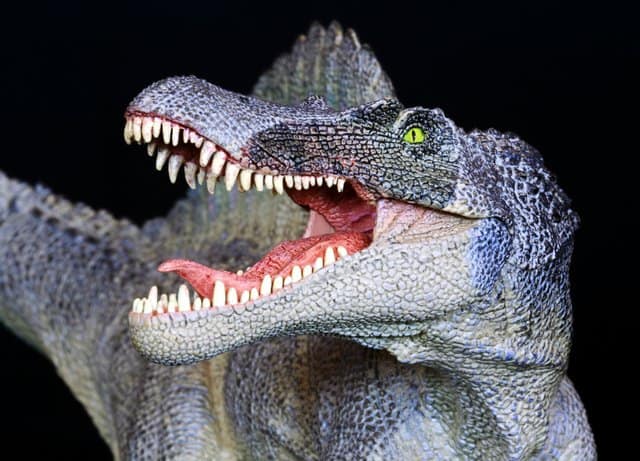
In this table, we look at the similarities and differences between the Spinosaurus and the Alligator.
| Characteristic | Spinosaurus | Alligator |
|---|---|---|
| Size | Up to 18 meters long | Up to 4.6 meters long (American alligator) |
| Diet | Mostly aquatic animals, but likely opportunistic | Opportunistic, feeding mainly on fish, turtles, various mammals, birds and other reptiles |
| Period of Existence | Mid-Cretaceous Period (112 to 93.5 million years ago) | Still existent, first appeared over 37 million years ago |
| Physical Structure | Walked on two legs, had a long, narrow skull and distinctive sail-like fin on its back | Walks on four legs, broad head, and no distinctive back structure |
| Habitat | Land and water (semi-aquatic) | Freshwater environments, such as ponds, marshes, wetlands, rivers, and swamps |
| Similarities | Both are carnivorous, have strong jaws, sharp teeth, and are excellent swimmers | |
Final Thoughts
Over the years, scientists have been studying and discussing not only how dinosaurs are related to alligators by using classifications together with fossils to make the connections, but even adding clades to clarify the relationships further. It gives great insight into whether alligators are related to dinosaurs.
Although there are modern-day animals that are closer to dinosaurs than alligators, I can’t help but think when I see an alligator in the zoo or on video that I’m looking at something alive and well during the time of the dinosaurs or even had similar features. Just take a look at the Spinosaurus, whose skull and tail resemble alligators!
Frequently Asked Questions
Are alligators related to dinosaurs?
No, alligators are not dinosaurs. While they share some similarities with dinosaurs, such as being reptiles and belonging to the group of animals known as archosaurs, alligators are not considered dinosaurs.
Did alligators live alongside dinosaurs?
Yes, alligators lived alongside dinosaurs during the Mesozoic Era, millions of years ago. However, it’s important to note that alligators are considered descendants of dinosaurs, but not actual dinosaurs themselves.
What are the differences between alligators and dinosaurs?
There are several differences between alligators and dinosaurs. Alligators are reptiles that belong to the crocodilian group, while dinosaurs are a larger group of reptiles that first appeared around 230 million years ago. Alligators have a more compact body shape, with a broad snout, while dinosaurs had a variety of body shapes and sizes. Additionally, alligators have a more limited range of movement compared to dinosaurs, who were known for their ability to walk and run on two legs.
Are alligators descendants of dinosaurs?
Yes, alligators are considered descendants of dinosaurs. Both alligators and dinosaurs share a common ancestor and belong to the larger group of reptiles known as archosaurs. However, it’s important to note that alligators are not direct descendants of dinosaurs, but rather branched off from the same lineage millions of years ago.
What are the similarities between alligators and dinosaurs?
While there are some similarities between alligators and dinosaurs, such as being reptiles and belonging to the group of archosaurs, the similarities are not extensive. Alligators and dinosaurs both had sharp teeth and were part of the reptile family, but their overall anatomy and behavior differed in many ways.
Can alligators be considered dinosaurs?
No, alligators cannot be technically considered dinosaurs. While both alligators and dinosaurs are reptiles and belong to the group of archosaurs, alligators are a distinct group within the reptile family. Dinosaurs, on the other hand, encompass a much larger group of reptiles with diverse characteristics.
When did dinosaurs go extinct?
Dinosaurs went extinct around 65 million years ago, at the end of the Cretaceous period. This extinction event wiped out a large majority of dinosaur species, leaving only a few descendants and relatives, such as birds, to survive and evolve.
Are alligators the closest living relatives to dinosaurs?
While alligators are considered descendants of dinosaurs, they are not the closest living relatives. Birds, specifically avian dinosaurs, are considered to be the closest living relatives to dinosaurs. Alligators and crocodiles are also related to dinosaurs, but they are not as closely related as birds.
Did alligators live alongside turtles during prehistoric times?
Yes, alligators lived alongside turtles during prehistoric times. Turtles are another group of reptiles that coexisted with alligators and dinosaurs. However, it’s important to note that turtles are not related to dinosaurs or alligators, but rather belong to their own distinct group within the reptile family.
Did alligators evolve from dinosaurs?
No, alligators did not evolve directly from dinosaurs. While alligators and dinosaurs share a common ancestor and belong to the larger group of reptiles known as archosaurs, alligators branched off from this lineage millions of years ago and evolved separately from dinosaurs.
